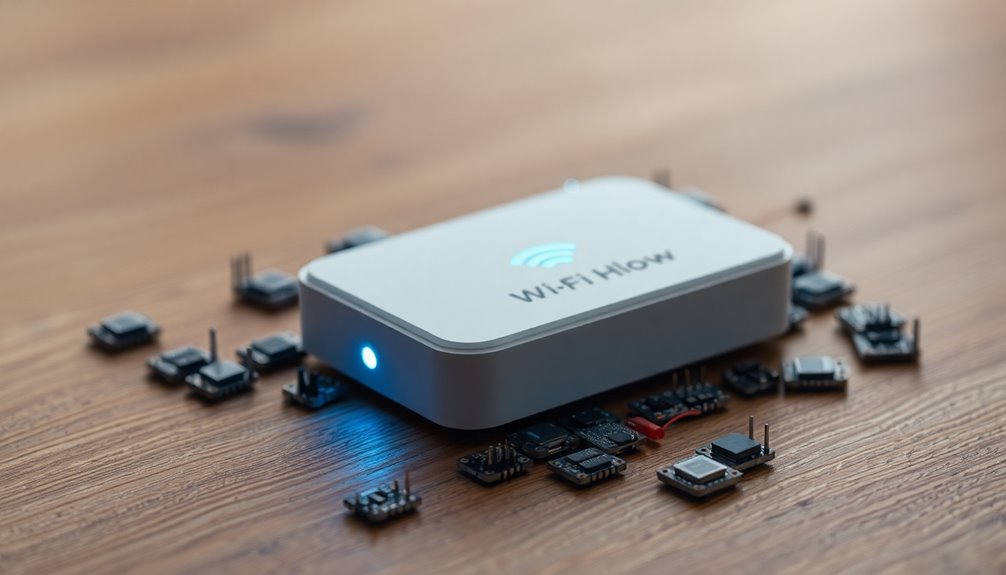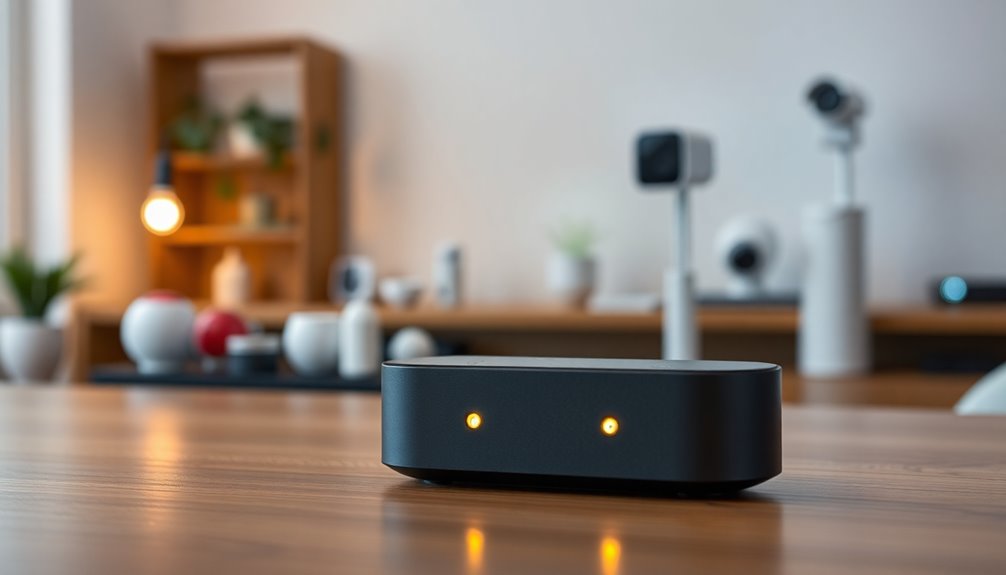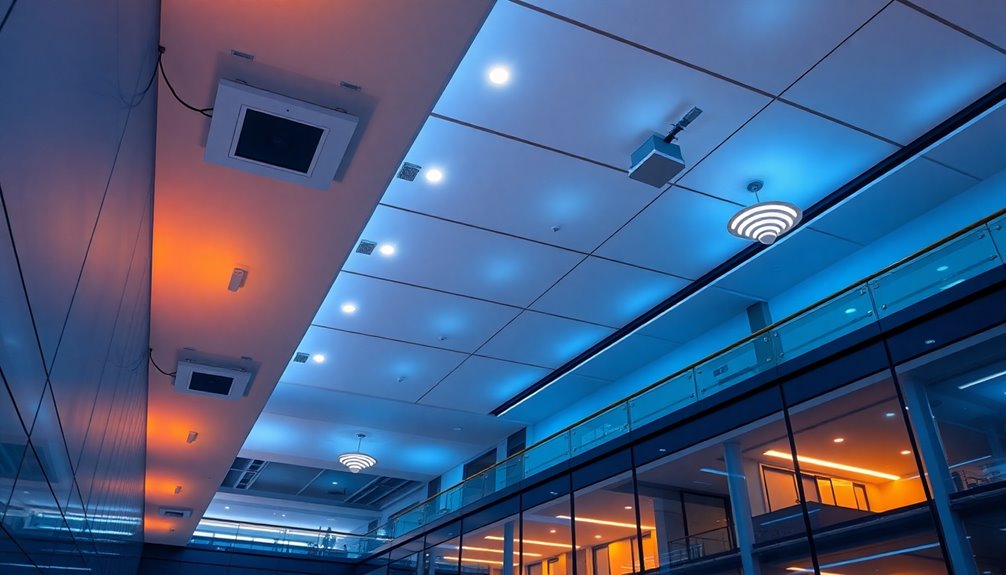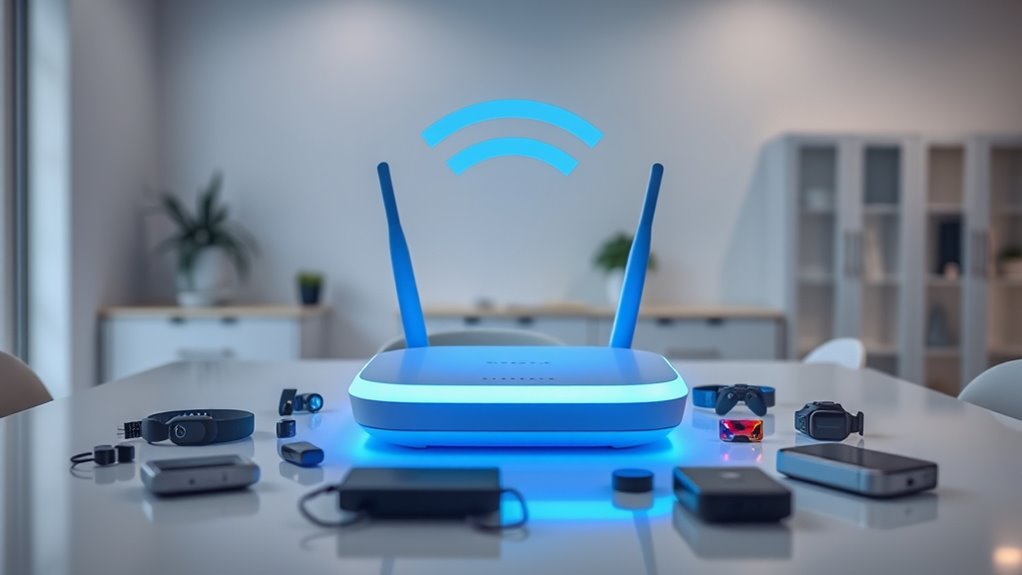Wi-Fi HaLow is a low-power wireless tech based on IEEE 802.11ah, designed for long-range and energy-efficient IoT connections. It operates in the sub-1 GHz band, allowing it to reach several kilometers and penetrate obstacles easily. With support for many devices and high data speeds, it’s perfect for smart buildings, agriculture, and city infrastructure. If you’re curious about how this technology can transform IoT networks, there’s more to discover ahead.
Key Takeaways
- Wi-Fi HaLow utilizes IEEE 802.11ah in the sub-1 GHz band, enabling long-range, low-power IoT connectivity.
- It supports battery life of multi-years for sensors and security devices through power-efficient protocols like TWT.
- Wi-Fi HaLow can connect thousands of devices within a single network, ideal for large-scale IoT deployments.
- It offers data rates up to 86.7 Mbps, suitable for high-bandwidth IoT applications such as HD video and sensor data.
- Its robust security features and compatibility with existing Wi-Fi infrastructure facilitate secure, seamless IoT integration.
What Is Wi-Fi HaLow and How Does It Work?

What exactly is Wi-Fi HaLow, and how does it operate? Wi-Fi HaLow is a wireless standard based on the IEEE 802.11ah protocol, introduced in 2016 to optimize IoT connectivity. It works in the sub-1 GHz spectrum, typically around 900 MHz, unlike traditional Wi-Fi that uses 2.4 GHz or 5 GHz. This lower frequency allows signals to travel farther and better penetrate obstacles, making it ideal for large deployments. Wi-Fi HaLow supports low power consumption, enabling devices like sensors and smart devices to operate for years on small batteries. It provides reliable, long-range communication and can connect many devices simultaneously. Its compatibility with existing Wi-Fi infrastructure and robust security features make it a flexible, scalable solution for various IoT applications. Additionally, its extended range makes it particularly suitable for smart city and agricultural deployments where extensive coverage is required. The protocol also includes features to manage multiple device connections efficiently, which is critical for expansive IoT networks. Moreover, understanding low-power networking is essential for designing sustainable IoT systems that minimize energy use while maximizing performance. An understanding of wireless spectrum management further enhances the deployment of these networks by reducing interference and optimizing bandwidth.
Extending Range and Improving Connectivity in IoT Networks

Wi-Fi HaLow substantially enhances IoT connectivity by leveraging the advantages of the sub-1 GHz frequency band, which enables signals to travel much farther and penetrate obstacles more effectively than traditional Wi-Fi. This frequency range allows signals to reach up to 3 km in line-of-sight and 300 meters through walls, ensuring reliable coverage in complex environments. Its lower interference levels reduce congestion, improving signal clarity in dense deployments. Long-range tests demonstrate live two-way video streaming over 3 km, while standardized deployments support 1 km coverage with omnidirectional antennas. Mesh networking enables multi-hop connections, extending coverage without proprietary hubs. This technology is ideal for large industrial facilities, farms, and urban areas, providing robust, wide-area connectivity for a vast array of IoT devices. Understanding the importance of Relationships – Personality Test] can help optimize network deployment strategies for better device interaction and management.
Power Efficiency and Battery Life Benefits for IoT Devices

Leveraging its operation in the sub-1 GHz band and advanced power management protocols, Wi-Fi HaLow considerably extends the battery life of IoT devices. Its lower frequency reduces path loss and transmission power needs, saving energy. Protocols like Target Wake Time (TWT) and Restricted Access Window (RAW) minimize active radio time, conserving battery. Support for sleep and power-saving modes allows devices to operate efficiently over long periods. Wi-Fi HaLow transfers more bits per joule than many competing technologies, boosting overall power efficiency. Shorter transmission durations further reduce power consumption per data exchange. Additionally, its design incorporates energy-efficient protocols that optimize power usage during network communication. Moreover, the use of low-power hardware components further enhances device longevity and reduces energy consumption. This approach aligns with wireless communication standards that promote sustainable IoT deployments. Implementing power management strategies can further maximize battery life in various environments. As a result, devices like sensors and security cameras can last multi-years on a single battery, especially in urban and industrial environments. This balance of low power use and reliable connectivity minimizes maintenance and extends device lifespan. Incorporating holistic SEO strategies can further enhance the visibility and adoption of Wi-Fi HaLow in the IoT market.
Data Rates and Performance Capabilities of Wi-Fi HaLow

Wi-Fi HaLow delivers a broad range of data rates that adapt to various operational conditions, from as low as 150 kbps to as high as 86.7 Mbps. Depending on distance, environment, and configuration, you can experience data rates exceeding 15 Mbps in some cases. The highest rate using MCS 9 reaches 4 Mbps with specific setups, but overall, Wi-Fi HaLow supports higher throughput than technologies like LoRaWAN—over 600 times faster. Its performance is enabled by advanced modulation techniques and efficient spectrum use, delivering bi-directional communication suitable for diverse IoT applications. With good range even in open environments, Wi-Fi HaLow can support data-intensive tasks like wireless HD video and large sensor networks, making it versatile for indoor and outdoor deployments.
Comparing Wi-Fi HaLow to Other Wireless Technologies

When comparing Wi-Fi HaLow to other wireless technologies, it’s clear that its unique combination of range, data rates, and security sets it apart. Operating in sub-GHz frequencies, Wi-Fi HaLow offers longer range and better obstacle penetration than traditional Wi-Fi, with data rates up to 15 Mbps—much higher than LoRa’s 50 Kbps. It balances low power consumption with high performance, making it suitable for real-time, bandwidth-intensive IoT applications. Unlike traditional Wi-Fi in 2.4 and 5 GHz bands, HaLow’s open IEEE 802.11ah standard simplifies network integration and reduces infrastructure costs by requiring fewer access points. Its IP-native architecture guarantees seamless compatibility with existing Wi-Fi ecosystems, providing a versatile, scalable solution for diverse IoT deployments. Additionally, AI-powered data analytics can optimize network performance and security in HaLow-enabled IoT environments, leveraging performance cookies to monitor and enhance operational efficiency. Furthermore, sustainable network design is increasingly important as IoT deployments expand, ensuring energy efficiency and environmental considerations are integrated into infrastructure planning. Incorporating energy-efficient protocols can further extend device battery life and reduce overall environmental impact. As advancements in wireless communication standards continue, Wi-Fi HaLow is poised to play a crucial role in enabling scalable and sustainable IoT ecosystems.
Key Applications in Industrial and Agricultural Settings

In industrial and agricultural environments, Wi-Fi HaLow enables reliable, long-range connectivity that supports a wide range of IoT applications. In factories, it powers predictive maintenance by connecting sensors for real-time equipment monitoring, reducing downtime. It streamlines process optimization through efficient data collection from sensors and actuators, improving control. Safety monitoring benefits from robust connectivity for safety equipment, ensuring timely interventions. Industrial control systems rely on seamless communication, facilitating precise operations and machinery automation, which lowers operational costs. In agriculture, Wi-Fi HaLow provides real-time soil, weather, and livestock data over extensive fields, helping with decision-making. It reduces infrastructure costs by minimizing wiring needs and boosts efficiency with reliable connectivity for automation. Support for precision farming techniques connects sensors and drones to optimize crop management and yields. Additionally, leveraging tuning techniques from vehicle customization can inspire innovative ways to enhance IoT device performance and adaptability, especially when considering energy-efficient communication methods to prolong device lifespan in remote areas. Implementing environmentally resilient hardware ensures devices operate effectively under challenging conditions typical of industrial and agricultural settings. Moreover, incorporating robust security protocols is essential to safeguard sensitive data transmitted across these expansive networks.
Enhancing Smart Buildings With Long-Range Connectivity

Long-range connectivity like Wi-Fi HaLow transforms how smart buildings operate by enabling extensive coverage and robust device integration. With over a kilometer of range, it easily covers large buildings and complexes, reducing the need for multiple access points. Its data speeds from 150 kbps to 80 Mbps support real-time services like security monitoring and device control. Wi-Fi HaLow can manage up to 8,000 devices on a single network, making it ideal for dense IoT deployments. Its low power protocols extend battery life for devices such as cameras and facial recognition systems. The technology enhances building management systems by providing reliable, widespread connectivity, supporting smart appliances, and enabling seamless data flow. This long-range approach reduces infrastructure costs and future-proofs your building’s IoT expansion. Additionally, predictive modeling can optimize network performance and maintenance schedules by analyzing device data over time. Incorporating power-efficient protocols further enhances device longevity and network stability in large-scale deployments. The integration of long-range connectivity also ensures consistent performance even in complex architectural environments, boosting overall system reliability.
Supporting Smart City Infrastructure and Urban Solutions

Wi-Fi HaLow enhances smart city infrastructure by providing reliable, long-range connectivity that supports a wide array of urban solutions. It enables real-time communication between traffic lights, sensors, and management systems, optimizing traffic flow and reducing congestion. Adaptive signal timing based on live data improves travel times and cuts vehicle emissions, all with minimal infrastructure. For parking management, Wi-Fi HaLow connects sensors across city lots, offering instant updates on space availability and guiding drivers efficiently. Its extensive coverage supports deploying numerous surveillance cameras and safety sensors, ensuring urban safety. Additionally, sensors monitor air quality, noise, and other environmental factors, aiding urban planning. Low power consumption extends device lifespan, reducing maintenance costs. Overall, Wi-Fi HaLow empowers cities with scalable, efficient, and sustainable smart infrastructure.
Integrating Wi-Fi Halow Into Existing Networks

How can Wi-Fi HaLow seamlessly integrate into your existing network infrastructure? To do so, you’ll need specialized access points (APs) operating in the sub-GHz spectrum, which connect via Ethernet to your current routers or switches. Both your router and devices must support the Wi-Fi HaLow standard to enable its benefits. Since it operates below 1 GHz, it offers longer range and lower power use, perfect for IoT devices. Wi-Fi HaLow provides native IP support, including IPv6, ensuring smooth integration with your existing IP network. It also supports multiple devices per SSID and over-the-air firmware upgrades, simplifying management. With robust security standards like WPA3 and interoperability across vendors, Wi-Fi HaLow can expand your network’s capacity and range without major disruptions or infrastructure overhaul.
Future Prospects and Growth Potential of Wi-Fi HaLow

The future of Wi-Fi HaLow looks promising, with adoption rates poised for rapid growth across multiple sectors. By 2029, over 100 million devices are projected to be in use globally, driven by sectors like smart homes, agriculture, and industrial applications. Its ability to operate in the sub-1 GHz spectrum offers extended range—up to ten times that of traditional Wi-Fi—and supports thousands of devices per access point, making it ideal for large-scale IoT deployments. Enhanced security and power efficiency further boost its appeal. As industry support grows and certification advances, Wi-Fi HaLow is positioned to become a foundational connectivity technology. Its scalability, low operational costs, and compatibility with existing networks will accelerate adoption, transforming IoT connectivity in diverse environments.
Frequently Asked Questions
How Does Wi-Fi Halow Ensure Security Across Diverse Iot Devices?
You want to know how Wi-Fi HaLow keeps your IoT devices secure. It uses robust features like WPA3 encryption to protect data, secure boot processes to verify firmware integrity, and mutual authentication to ensure only authorized devices connect. Additionally, it employs secure communication protocols, manages device discovery and connection setup, and detects threats, all while offering long-range, low-power connectivity that enhances security coverage and reduces vulnerabilities in your network.
What Are the Typical Deployment Challenges for Wi-Fi Halow Networks?
Deploying Wi-Fi HaLow networks is like assembling a complex puzzle—you need to carefully plan access point placement and navigate physical obstacles. You’ll face challenges like interference from heavy machinery, thick walls, and environmental factors that weaken signals. Ensuring interoperability with diverse IoT devices, managing power consumption, and scaling the network cost-effectively are also demanding tasks. Proper planning and flexibility help overcome these hurdles for a reliable, wide-reaching IoT network.
Can Wi-Fi Halow Support Real-Time Data Transmission for Critical Applications?
You’re wondering if Wi-Fi HaLow can handle real-time data transmission for critical applications. It certainly can, supporting data rates from 150 kbps to 86.7 Mbps, ideal for timely information exchange. Its long-range capabilities, low power consumption, and support for IPv6 make it suitable for industrial asset tracking, emergency response, and large-scale monitoring. Plus, its security standards ensure data remains protected during real-time transmission, making it dependable for essential applications.
How Does Wi-Fi Halow Handle Device Mobility Within Networks?
You want to know how Wi-Fi HaLow manages device mobility within networks. It handles this by operating below 1 GHz, offering long-range connectivity up to 3 km and penetrating obstacles easily. The protocol enables seamless handoffs between access points, supports multi-vendor interoperability, and maintains security during movement. Its low power design, extended range, and robust network architecture guarantee your devices stay connected smoothly as they move across different environments.
What Are the Licensing and Regulatory Considerations for Sub-1 GHZ Spectrum Use?
Did you know that over 80% of IoT devices in some regions operate in unlicensed sub-1 GHz bands? When using this spectrum, you need to take into account licensing and regulatory rules, which vary globally. You’ll face restrictions on power limits, emissions, and duty cycles. In some areas, you must apply for licenses, while in others, you can operate license-free. Compliance with standards like FCC or ETSI is essential for legal and interference-free operation.
Conclusion
Think of Wi-Fi HaLow as the gentle giant of IoT connectivity, quietly extending its reach and saving energy like a wise old tree providing shade. It’s transforming smart buildings and cities, making everything more connected and efficient. As it continues to grow, you’ll find it becoming the backbone of your IoT ecosystem, bridging gaps effortlessly. Embrace Wi-Fi HaLow, and watch your smart world flourish like a garden in full bloom.









